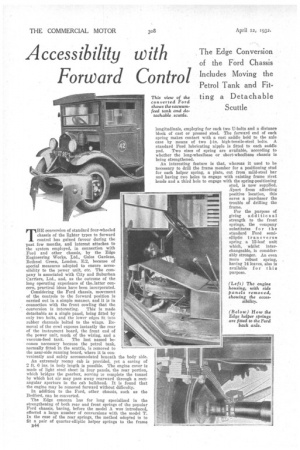Accessibility with Forward Control
Page 62

If you've noticed an error in this article please click here to report it so we can fix it.
The Edge Conversion of the Ford Chassis Includes Moving the Petrol Tank and Fitting a Detachable Scuttle
BE conversion of standard four-wheeled chassis of the lighter types to forward control has gained favour during the past few months, and interest attaches to the system employed, in connection with Ford and other chassis, by the Edge Engineering Works, Ltd., Gales Gardens, Bethnal Green, London, E.2, because of special measures adopted to ensure accessibility to the power unit, etc. The company is associated with City and Suburban Carriers, Ltd., and, as the outcome of the long operating experience of theAtitter concern, practical ideas have been incorporated.
Considering the Ford chassis, movement of the controls to the forward position is carried out in a simple manner, and it is in connection with the front cowling that the
conversion is interesting. This is made detachable as a single panel, being fitted by only two bolts, and the lower edges fit into rubber channels bolted to the wings. Removal a the cowl exposes instantly the rear of the instrument board, the front end of the power unit, much of the wiring, and a T vacuum-feed tank. The last named becomes necessary because the petrol tank, normally fitted in the scuttle, is removed to the near-side running board, where it is conveniently and safely accommodated beneath the body side.
An extremely roomy cab is pravided, yet a saving of 2 ft. 6 ins, in body length is possible. The engine cover is made of light steel sheet in four panels, the rear portion, which bridges the gearbox, serving to complete the tunnel by which hot air may pass away rearward through a rectangular aperture in the cab bulkhead. It is found that the engine may be removed forward withOut difficulty. In addition to the Ford, other chassis, such as the Bedford, can be converted.
The Edge concern has for long specialized in the strengthening of both rear and front springs of the popular Ford chassis, having, before the model A was introduced, effected a large number of conversions with the model T. In the case of the rear springs, the method adopted is to fit a pair of quarter-elliptic helper springs to the frame B44 longitudinals, employing for each two U-bolts and a distance block of cast or pressed steel. The forward end of each spring makes contact with a cast saddle held to the axle case by means of two 1-in. high-tensile-steel bolts. A standard Ford lubricating nipple is fitted to each saddle pad. Two sizes of spring are available, according to whether the long-wheelbase or short-wheelbase chassis is being strengthened.
An interesting feature is that, whereas it used to be necessary to drill the frame member for a positioning stud for each helper spring, a plate, cut from mild-steel bar and having two holes to engage with existing frame rivet heads and a third hole to engage with the spring-positioning stud, is now supplied. Apart from affording positive location, this saves a purchaser the trouble of drilling the frame.
For the purpose of giving additional strength to the front springs, the company substitutes for t he standard Ford semielliptic transverse spring a 12-leaf unit which, whilst interchangeable, is considerably stronger. An even more robust spring, having 14 leaves, also is available for thiu purpose.




































































































